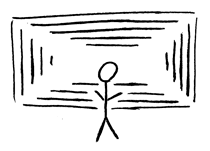| back to index | |||
H13 Immersive Display * |
|||
 CAVE in the Ars Electronica Center Linz. |
|||
|
....you have decided to create an exhibit that several people
can experience simultaneously - Cooperative Experience. Now you need to find a way to
design the visual output of such a system.
|
|||
|
* * *
|
|||
| Typical usage scenarios of standard computer systems often
involve only one human interacting with the computer at any time, and
the system is only a small part of the real environment of the user.
But exhibits are usually visited by groups of people, and when users
interact with them, they are ready to immerse themselves into the
world of the exhibit.
|
|||
|
|
|||
| CAVE: 3-D walls |
The CAVE installation in the Ars Electronica Center in Linz uses wall-size projections all around the visitors to immerse them into a virtual reality. Special glasses synchronize with these displays to create a three-dimensional impression. |
||
| Virtual Vienna: panorama |
Virtual Vienna uses a rear-projected display screen of about 1.6 m width, with the users standing at the same distance to the screen. This fills most of the optical viewing field when looking at the screen, and helps people to feel like they are actually standing at the place whose panorama is being displayed. |
||
| Personal Orchestra: large projection | Personal Orchestra uses an even bigger display area of about 2.5 m width, again with a corresponding viewing distance. This conveys the impression of actually standing in front of the Vienna Philharmonic in a far better way than it would on a small computer monitor.
With these systems, this large display not only immerses the main
user into the experience, it also allows several bystanders to
at least observe the exhibit in action, which many may find already
sufficient without becoming an active user. |
||
|
Therefore: Prefer a single exhibit with a large-scale display, with a minimum of 1.5 m in display width, over several similar stations with smaller displays, and over other output devices that shield a single user from his co-visitors, such as head-mounted displays. Design for a viewing distance that roughly equals the width of the display. |
|||
 |
|||
|
* * *
|
|||
|
If you hide the display technology, it can become a "magic image" - Invisible Hardware.
|
|||
This pattern is taken from the book "A Pattern Approach to Interaction Design" (PAID) by Jan Borchers (John Wiley and Sons, Chichester, UK, 2001). Copyright 2001 John Wiley and Sons. Used by permission. See http://media.informatik.rwth-aachen.de/paid.html for more information. Online version by Susan Babutzka, ETH Zurich (subabutz_at_student.ethz.ch). |
|||